Themed collection Hydrogel properties and applications

Hydrogel properties and applications
Guest editors Jun Fu and Marc in het Panhuis introduce this Journal of Materials Chemistry B themed issue on hydrogel properties and applications.

J. Mater. Chem. B, 2019,7, 1523-1525
https://doi.org/10.1039/C9TB90023C
Understanding hydrogelation processes through molecular dynamics
Molecular dynamics (MD) is currently one of the preferred techniques employed to understand hydrogelation processes for its ability to include large amounts of atoms in computational calculations, since substantial amounts of solvent molecules are involved in gel formation.

J. Mater. Chem. B, 2019,7, 1652-1673
https://doi.org/10.1039/C8TB03036G
Considerations for hydrogel applications to neural bioelectronics
Hydrogels have garnered interest as materials in bioelectronics due to the capacity to tailor their properties. Appropriate selection and design of hydrogel systems for this application requires an understanding of the physical, chemical and biological properties as well as their structure–property relationships.

J. Mater. Chem. B, 2019,7, 1625-1636
https://doi.org/10.1039/C8TB02763C
Progress in self-healing hydrogels assembled by host–guest interactions: preparation and biomedical applications
Preparation and biomedical applications of self-healing hydrogels assembled from hosts of cyclodextrins and cucurbit[n]urils with various guests were reviewed.
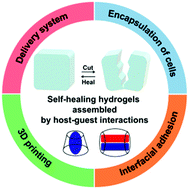
J. Mater. Chem. B, 2019,7, 1637-1651
https://doi.org/10.1039/C8TB02547A
Shape-changing polymers for biomedical applications
Smart polymers that are capable of controlled shape transformations under external stimuli have attracted significant attention in the recent years due to the resemblance of this behavior to the biological intelligence observed in nature. In this review, we focus on the recent progress in the field of shape-morphing polymers, highlighting their most promising applications in the biomedical field.
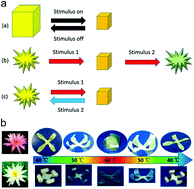
J. Mater. Chem. B, 2019,7, 1597-1624
https://doi.org/10.1039/C8TB02579G
Retracted Article: Development of functional hydrogels for heart failure
Hydrogel-based approaches were reviewed for cardiac tissue engineering and myocardial regeneration in ischemia-induced heart failure, with an emphasis on functional studies, translational status, and clinical advancements.
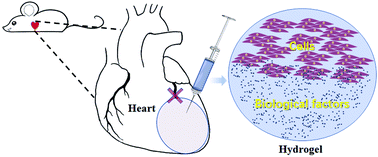
J. Mater. Chem. B, 2019,7, 1563-1580
https://doi.org/10.1039/C8TB02591F
Semicrystalline physical hydrogels with shape-memory and self-healing properties
Synthetic hydrogels are generally amorphous in nature without any order at the molecular level.
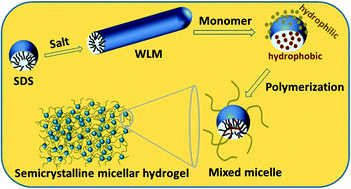
J. Mater. Chem. B, 2019,7, 1581-1596
https://doi.org/10.1039/C8TB02767F
Multifunctional cellulose-based hydrogels for biomedical applications
This review focuses on state-of-the-art progress in cellulose-based hydrogels, and emphasizes their fascinating properties and biomedical applications.
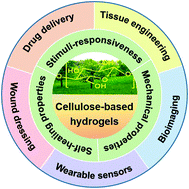
J. Mater. Chem. B, 2019,7, 1541-1562
https://doi.org/10.1039/C8TB02331J
Dynamic hydrogels mediated by macrocyclic host–guest interactions
The recent progress in dynamic hydrogels mediated by macrocyclic host–guest interactions is reviewed.
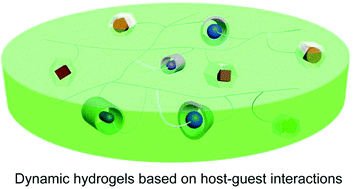
J. Mater. Chem. B, 2019,7, 1526-1540
https://doi.org/10.1039/C8TB02339E
Electrochemical-mediated gelation of catechol-bearing hydrogels based on multimodal crosslinking
Applying full cell potential estimation in redox pairs of [PEG-Cat]4 + Mz+ to elucidate contributions of metal ion precursors on hydrogel properties.
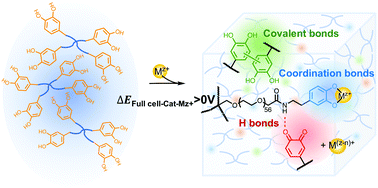
J. Mater. Chem. B, 2019,7, 1690-1696
https://doi.org/10.1039/C8TB02854K
Thermo- and photo-responsive composite hydrogels with programmed deformations
Composite hydrogels were fabricated by photolithographic polymerization to form a non-responsive gel and subsequent thermal polymerization to form a dual-responsive gel. These composite gels with heterogeneous structures showed programmed deformations upon heating or light irradiation.
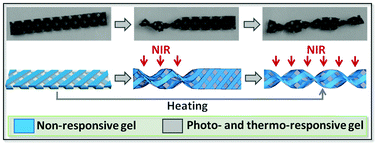
J. Mater. Chem. B, 2019,7, 1674-1678
https://doi.org/10.1039/C8TB02896F
Macroscopic supramolecular assembly of rigid hydrogels assisted by a flexible spacing coating
A flexible spacing coating is introduced to a rigid hydrogel surface to improve the surface compliance for efficient macroscopic supramolecular assembly.
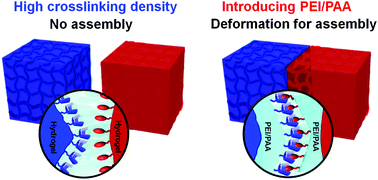
J. Mater. Chem. B, 2019,7, 1684-1689
https://doi.org/10.1039/C8TB02588F
A shape-shifting composite hydrogel sheet with spatially patterned plasmonic nanoparticles
A simple and reliable approach was developed to fabricate thermo-responsive composite hydrogel sheets with spatially patterned regions of plasmonic gold nanoparticles. The same hydrogel exhibited different modes of shape deformation under near-infrared laser irradiation depending on the irradiation direction.
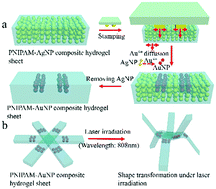
J. Mater. Chem. B, 2019,7, 1679-1683
https://doi.org/10.1039/C8TB01959B
Influence of charged groups on the cross-linking efficiency and release of guest molecules from thiol–ene cross-linked poly(2-oxazoline) hydrogels
This study concerns hydrogels obtained from poly(oxazolines) bearing charged groups and their effect on the loading and release of guest molecules.

J. Mater. Chem. B, 2019,7, 1782-1794
https://doi.org/10.1039/C8TB02575D
Zwitterionic poly(sulfobetaine methacrylate) hydrogels with optimal mechanical properties for improving wound healing in vivo
Zwitterionic hydrogels, as highly hydrated and soft materials, have been considered as promising materials for wound dressing, due to their unique antifouling and mechanical properties.
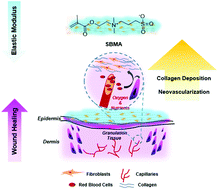
J. Mater. Chem. B, 2019,7, 1697-1707
https://doi.org/10.1039/C8TB02590H
Effect of gelatin source and photoinitiator type on chondrocyte redifferentiation in gelatin methacryloyl-based tissue-engineered cartilage constructs
This work investigates neocartilage formation in bovine and porcine gelatin methacryloyl-based hydrogels photocrosslinked using ultraviolet or visible light photoinitiator systems.

J. Mater. Chem. B, 2019,7, 1761-1772
https://doi.org/10.1039/C8TB02607F
3D cell printing of islet-laden pancreatic tissue-derived extracellular matrix bioink constructs for enhancing pancreatic functions
3D cell printing using pdECM bioink can recapitulate pancreatic tissue specific microenvironmental niche that can induce higher insulins production by islets.

J. Mater. Chem. B, 2019,7, 1773-1781
https://doi.org/10.1039/C8TB02787K
Tailoring supramolecular guest–host hydrogel viscoelasticity with covalent fibrinogen double networks
Supramolecular chemistry has enabled the design of tunable biomaterials that mimic the dynamic and viscoelastic characteristics of the extracellular matrix.
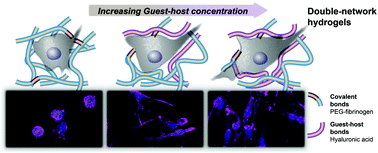
J. Mater. Chem. B, 2019,7, 1753-1760
https://doi.org/10.1039/C8TB02593B
A DOPA-functionalized chondroitin sulfate-based adhesive hydrogel as a promising multi-functional bioadhesive
A novel DOPA-functionalized chondroitin sulfate-based (CSD) bioadhesive hydrogel with excellent functionality and biocompatibility for internal medical applications.
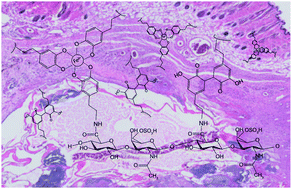
J. Mater. Chem. B, 2019,7, 1741-1752
https://doi.org/10.1039/C8TB01990H
Stretchy and strong polyurethane–urea supramolecular (PUUS) hydrogels with various stimulus-responsive behaviours: the effect of chain-extenders
This paper provides an easy synthetic strategy combined with straightforward tailoring of the physical properties and functionalities, such that optimal performance can be targeted for various applications of strong and tough supramolecular hydrogels.
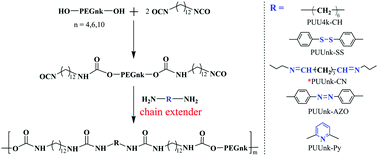
J. Mater. Chem. B, 2019,7, 1734-1740
https://doi.org/10.1039/C8TB02585A
Conductive regenerated silk-fibroin-based hydrogels with integrated high mechanical performances
Strong and tough RSF-based hydrogels that could be used as a strain sensor, a touch screen pen and an electronic skin were developed.
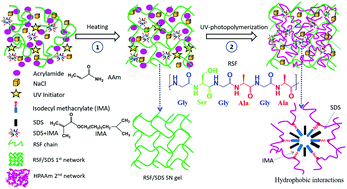
J. Mater. Chem. B, 2019,7, 1708-1715
https://doi.org/10.1039/C8TB02445F
Mussel-inspired dopamine oligomer intercalated tough and resilient gelatin methacryloyl (GelMA) hydrogels for cartilage regeneration
Gelatin methacryloyl (GelMA) hydrogels are widely used for tissue regeneration.
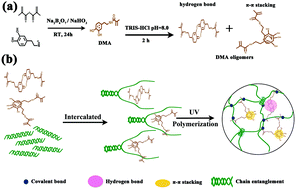
J. Mater. Chem. B, 2019,7, 1716-1725
https://doi.org/10.1039/C8TB01664J
Manipulating the mechanical properties of biomimetic hydrogels with multivalent host–guest interactions
Biomimetic hydrogels with multivalent host–guest interactions as reversible crosslinks provide not only energy storage capacity, but also energy dissipation capacity to the dually crosslinked networks.
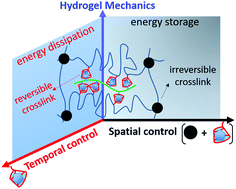
J. Mater. Chem. B, 2019,7, 1726-1733
https://doi.org/10.1039/C8TB02021C
Bioinspired reversible hydrogel adhesives for wet and underwater surfaces
A hydrogel-based wet adhesive with bioinspired microstructures can exhibit strong and reversible adhesion to wet and underwater surfaces.
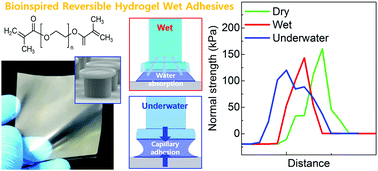
J. Mater. Chem. B, 2018,6, 8064-8070
https://doi.org/10.1039/C8TB02598C
About this collection
Guest edited by Jun Fu (Ningbo Institute of Materials Technology and Engineering, Chinese Academy of Sciences) and Marc in het Panhuis (University of Wollongong).
This themed issue of Journal of Materials Chemistry B focuses on the latest progress in the field of polymer-based hydrogels, such as tough hydrogels, multifunctional hydrogels, responsive hydrogels, self-healing hydrogels, and smart hydrogel devices.
Polymer-based hydrogels have attracted increasing research interest for their wide range of chemical structures and excellent physical properties that have resulted in the suitability of these materials for applications in the fields of biosensors, soft actuators, artificial muscles, and biomedical engineering. Recently, significant research efforts have been devoted to tough hydrogels with non-covalent or supramolecular energy dissipation mechanisms, smart hydrogels comprised of functional moieties, and devices delicately fabricated from tough and smart hydrogels. However, practical applications dictate the necessity of the realisation of hydrogels with outstanding toughness, strength, self-healing, and fatigue resistance.